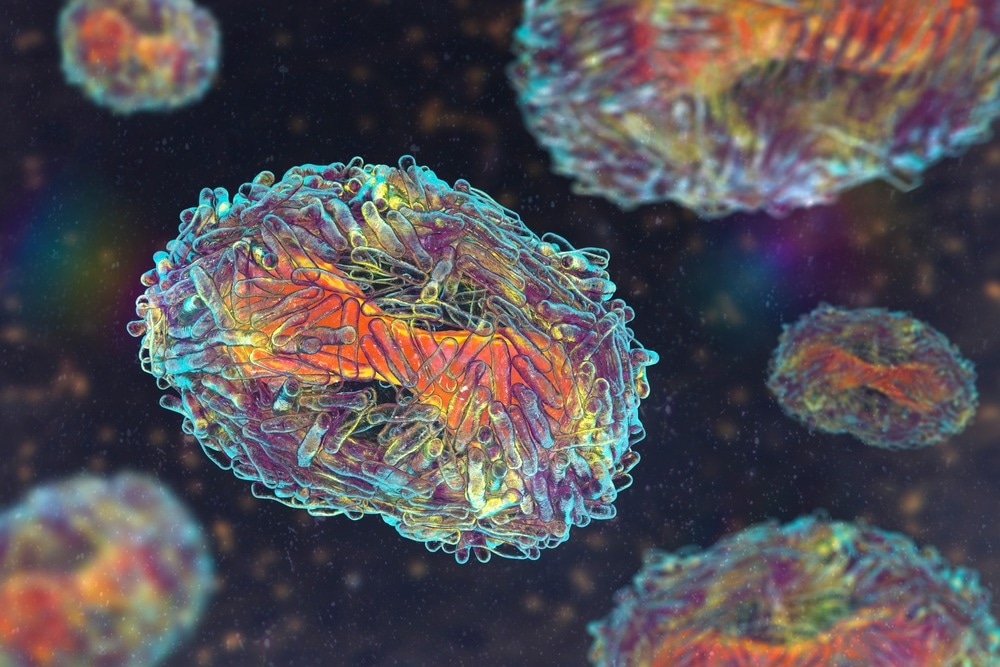In a recent study posted to the bioRxiv* preprint server, researchers explored genomic rearrangements in monkeypox (MPX) virus (MPXV) genomes and investigated whether such rearrangements represented viral adaption to humans (host).

Background
Studies have reported that poxviruses evolve at a slower rate compared to ribonucleic acid (RNA) viruses, with genomic rearrangements such as gene loss or gain as the key drivers for adaption to hosts. In 2022, the MPXV outbreak has affected most parts of the world, and MPX appears to have been established in human communities.
About the study
In the present study, researchers assessed MPXV genomic losses and gains and investigated if they were representative of MPXV adaptation to human hosts.
A total of 339 samples confirmed as MPXV-positive by polymerase chain reaction (PCR) were sequenced by whole-genome sequencing (WGS) analysis. The team extracted deoxyribonucleic acid (DNA) from the samples and prepared shotgun libraries. They constructed MPXV genomes by de novo assembly and mapped them to a reference protein sequence. The sequences were aligned, and all genomes were conveyed to the NCBI (National Center for Biotechnology Information) GenBank database.
Results
The team reported five 2022 outbreak MPXV genomes with extensive gene duplications and losses, including duplications of up to 18,000 base pairs (bp) to the opposed genomic end from the left (L) to the right (R) terminal inverted repeats (ITR) region, and insertion site deletions of up to 16,000 bp, as a probable human host adaption.
The L to R duplications were also found in a clade I MPXV genome from 2005 and in a genome from the current 2022 multi-national MPXV outbreak. In addition, the R to L end duplications was noted with the MPXV/Germany/2022/RKI339 genome. The MPXV/Germany/2022/RKI338 genome showed a 2,309 bp deletion in the same site downstream of the L ITR but devoid of an insertion.
Identical duplications were observed among 20 II clade MPXV genomes between 1958 and 2018. The MPXV/Germany/2022/RKI335 genome showed duplications from the area downstream of the L ITR, inclusive of the MPXVgp-005 and -007 genes, to the area located above the R ITR between the MPXVgp-182 and -188 genes, resulting in MPXVgp-184 and -187 truncation and complete MPXVgp185 and MPXVgp186 deletion.
The duplication size (2921 base pairs) to the R terminal region and the 8893 bp-deletion led to the formation of a 191176 bp-long total genome with ITR region extension between 6400 bp and 9398 bp. Identical deletion and duplications were observed in the MPXV/Germany/2022/RKI336 genome with MPXVgp-005 to -008 gene duplication and insertion between MPXVgp-177 and -188 at the R end, with MPXVgp187 truncation and complete MPXVgp-178 to -186 gene deletion.
Genetics & Genomics eBook

A 4040 bp duplication and 15303 bp deletion led to the formation of a 185852 bp-long genome with 10460 bp ITRs. The MPXV/Germany/2022/RKI337 genome demonstrated an identical deletion and duplication pattern, with the greatest 5282 bp-long duplications [MPXVgp-005 to -010 (shortened)] towards the R terminal region with the greatest 16926 bp deletion [MPXVgp-176 to -187 (shortened)]. The length of the MPXV/Germany/2022/RKI337 genome was 185251 bp with 11641 base pair ITRs.
The MPXV Sudan 2005 genome exhibited a 10550-base pair-long duplication at the same region post the L to R ITR and a 2108 bp deletion. The duplication in the E-ChVir28389 genome showed an 858 bp duplication from the L to R ITR and a 2048 bp deletion. In addition, R to L end duplications were observed for the MPXV/Germany/2022/RKI339 genome that had 18214 bp duplication [genes MPXVgp174 (shortened) to 187 (shortened)] to the L terminal region, leading to MPXVgp-005 to -010 gene deletions of 6701 base pairs.
The length of the genome increased to 208804 bp with 24695 bp extended ITRs. All L to R duplications included ≥1 of the MPXVgp-005 to -014 genes with deletion of ≥1 MPXVgp-175 to -187 genes or vice versa for R to L duplications. Deleted genes correlated with antigenic signal losses or continued evolutionary persistence by disease attenuation.
Contrastingly, acquired genes may favor immune evasion of host defense responses. MPXVgp-006 is an epidermal growth factor-like protein with homology to the vaccinia virus C11R gene, and cell culture experiments have shown that C11R lowers nuclear factor kappa B (NF-κB) activation. Other genes duplicated were MPXVgp-008 (zinc-finger protein, apoptosis inhibition), MPXVgp-009 [interleukin (IL)-18 functional inhibitor], and MPXVgp010 (shortened ankyrin or host range protein).
Further, all L to R duplications caused deletions of at least MPXVgp-184 (shortened) to -187 (shortened), and MPXVgp-184,186 did not show orthopoxvirus homology. MPXVgp-185 showed homology to the vaccinia B22R gene that is homologous to inhibitors of serine protease. B22R deletion has been documented to reduce vaccinia virus virulence and replication.
For the MPXV/Germany/2022/RKI337 and MPXV/Germany/2022/RKI336 genes, MPXVgp180 (B19R) and MPXV182 (B21R) were deleted further and were identified as candidates of potentially key MPXV virulence genes. The third candidate D10L (MPXVgp013), and the B19R and B21R genes were duplicated in the MPXV/Germany/2022/RKI339 genome, and the fourth one was duplicated in the Sudan KC257459 MPXV genome.
Conclusion
Overall, the study findings highlighted gene duplications and losses as probable mechanisms of the current 2022 outbreak MPXV for host adaption and underscored the need for continued surveillance efforts for the MPXV genome ends instead of or in conjunction with the ongoing non-synonymous MPXV mutation monitoring.
*Important notice
bioRxiv publishes preliminary scientific reports that are not peer-reviewed and, therefore, should not be regarded as conclusive, guide clinical practice/health-related behavior, or treated as established information.
- Possible adaption of the 2022 Monkeypox virus to the human host through gene duplication and loss. Annika Brinkmann et al. bioRxiv. doi: https://doi.org/10.1101/2022.10.21.512875 https://www.biorxiv.org/content/10.1101/2022.10.21.512875v1
Posted in: Medical Science News | Medical Research News | Disease/Infection News
Tags: Apoptosis, Biotechnology, Cell, Cell Culture, DNA, Gene, Genes, Genome, Genomic, Growth Factor, Homologous, Interleukin, Monkeypox, Mutation, Polymerase, Polymerase Chain Reaction, Protein, Ribonucleic Acid, RNA, Serine, Vaccinia Virus, Virus, Zinc

Written by
Pooja Toshniwal Paharia
Dr. based clinical-radiological diagnosis and management of oral lesions and conditions and associated maxillofacial disorders.
Source: Read Full Article
